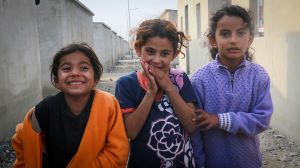 A new study published in the International Journal of Environmental Research and Public Health looked at the displacement and isolation of Syrian refugees in Texas.
A new study published in the International Journal of Environmental Research and Public Health looked at the displacement and isolation of Syrian refugees in Texas.
“We initiated a study in the Houston-based Syrian refugee population to examine their post-migratory living conditions, trauma susceptibility and resiliency to gain understanding of their physical and mental well-being,” study author Samina Salim told us. Salim is an associate professor of pharmacology at the University of Houston, College of Pharmacy. “My co-investigator, Dr. Johanna Bick, and I have long-standing interests in trauma and stress research. My life-long goal is to study mental health within a neuro-socioecological context. As a scientist, I have extensive experience in basic neuroscience, but my core interests are anchored in the real-life domains of health, social, and human phenomena which could be studied to improve mental health outcomes.”
Syrians are the largest forcibly displaced population in the world, although this is about to change with the current Ukrainian crisis. An estimated 20,000 Syrian refugees have resettled in the U.S. Early intervention is critical to facilitate their successful integration into American society to prevent socio-economic and health burdens. To effectively conduct the intervention, the problems must first be identified.
“We initiated the study with an open mind,” Salim told us. “Considering the traumatic lives of Syrian refugees, having experienced the horrors of war and conflict and the stress of displacement, we were interested in understanding their mental well-being.”
The research team partnered with several local community organizations which cater specifically to refugees from the MENA region and recruited Syrian refugees into this study with their help. They conducted surveys which included a sociodemographic questionnaire with general questions on the demographic and psychosocial circumstances including age, gender, education level, socio-economic status, relationship status, health care access and prevalence of chronic diseases.
Measures of mental health, stress and distress, post conflict situations, and post migration stress sources were included utilizing validated Arabic versions of Self-Reporting Questionnaire (SRQ), Perceived Stress Scale (PSS), Afghan Symptoms Checklist (ASC), and Refugee Post-Migration Stress Scale (RPMSS), respectively. In addition to the questionnaires, researchers also conducted qualitative interviews.
Results were then subjected to descriptive statistical analysis to conduct sample comparisons between males and females using independent t-test or chi-square tests for continuous and categorical variables, respectively. Analysis of covariance (ANCOVA) was used to examine the association of gender and the stress scale while controlling for participant age. ANCOVA was conducted separately for each stress scale. The intercorrelation between each stress scale and participant characteristics were also examined.
“The study results showed that Syrian refugee females reported higher stress and distress than males,” Salim told us. “Displacement from home country and social strain were the highest source of stress in Syrian refugee females as indicated from results obtained in the RPMSS. The results were not shocking as other studies conducted in other host countries have suggested high stress in refugee women, but the extent of isolation and exclusion Houston-based Syrian women face was surprising.”
Salim and the researchers believe now that the problem has been identified, the next step is to recommend mitigating interventions. Their recommendation is to invest in community outreach programs which can be critical in addressing mental health needs of this high-risk group. Outreach efforts can be implemented through a network of educators and outreach workers involving faith-based leaders and community workers who speak Arabic and are culturally competent. The dissemination of mental health education and social behavior change promoting healthy living can be implemented through language-tailored culturally sensitive infographics, social media messaging and other grassroot level operations.
“There is a critical need for Arabic mental health literature that is easily understood and adopted in the Arab American communities,” Salim told us. “Arab women, in general, face unique sociocultural factors including social stigma, strong patriarchal culture and fatalistic beliefs, which discourages them from seeking preventive health care especially as it relates to mental health, hence grassroot level community work enabled via faith-based organizations can be vital in addressing the problems identified in the study. Not much attention is paid to these issues, leaving this group one of the most marginalized and under-researched groups in the US. Therefore, initiatives with intentional action are needed.”
Patricia Tomasi is a mom, maternal mental health advocate, journalist, and speaker. She writes regularly for the Huffington Post Canada, focusing primarily on maternal mental health after suffering from severe postpartum anxiety twice. You can find her Huffington Post biography here. Patricia is also a Patient Expert Advisor for the North American-based, Maternal Mental Health Research Collective and is the founder of the online peer support group - Facebook Postpartum Depression & Anxiety Support Group - with over 1500 members worldwide. Blog: www.patriciatomasiblog.wordpress.com
Email: tomasi.patricia@gmail.com